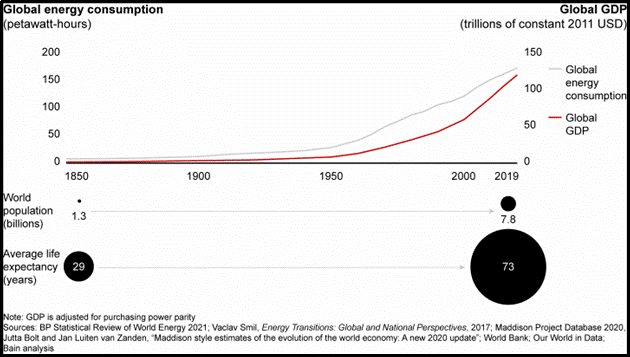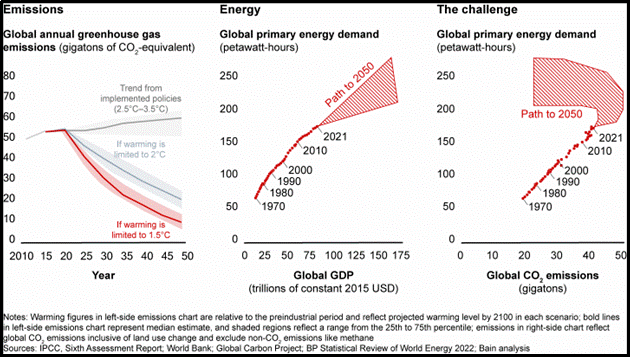The Herculean Energy Transition Endeavour

The 21st century finds itself at a crossroads where the need to meet escalating energy demands clashes head-on with the imperative to reduce greenhouse gas emissions
Over the past 18 months, energy security has emerged as a paramount concern on the global stage. This newfound prominence accentuates the intricate web of trade-offs and complexities inherent in navigating the transition to a new energy era. At its core, this challenge encompasses the formidable task of severing the historical tether that binds energy production to greenhouse gas emissions.
Solving this conundrum mandates an unprecedented scale and velocity of change, underscored by substantial infrastructure investments. To contextualise this mammoth endeavour, consider that, by one measure encapsulated in the IEA’s Net Zero Emissions by 2050 Scenario, the world must roughly double its 2022 pace of total energy investment by 2030 and maintain this trajectory, or slightly diminish it, through 2050 to achieve net-zero emissions. This endeavour necessitates an almost threefold increase in annual investments in clean energy.
Crucially, energy and natural resource companies stand as central figures in every facet of the impending transition. The decisions and actions of these entities will wield immense influence over the ultimate outcome of the dual challenge. It’s a narrative that carries profound implications for the course of the energy landscape.
The Dual Challenge
Amidst this intricate tapestry of challenges and opportunities, one indomitable truth persists: the world’s hunger for energy continues to surge. While the historical expansion of primary energy sources since the 19th century has fuelled unprecedented human progress and longevity, its benefits have not been equitably distributed. Energy poverty persists, predominantly in the Global South, where approximately 675 million individuals lack access to electricity, and nearly 30% of the world’s population, totalling 2.3 billion people, lack access to clean cooking fuels and technologies, jeopardising their lives due to indoor air pollution.
The future trajectory of global population growth places a magnifying glass on this issue. Regions such as sub-Saharan Africa are expected to experience a near doubling of their population. Consequently, the world’s appetite for energy becomes more voracious than ever.
Yet, herein lies the quandary: our primary energy sources, predominantly fossil fuels, concurrently serve as the principal culprits behind anthropogenic greenhouse gas emissions. These fossil fuels account for approximately 80% of our primary energy supply, and this dependence has seen scant alteration over the past three decades. The result is an escalating concentration of greenhouse gases in the atmosphere, primarily attributable to fossil fuel production and combustion. Scientific consensus unequivocally warns of dire consequences for human well-being if this trend persists.
This tension between the inexorable demand for energy and the imperative to mitigate climate change underscores the dual challenge of the 21st century. It poses the question: How can the world augment energy supply while concurrently curtailing emissions?
Energy and natural resource executives find themselves acutely cognizant of these imperatives. However, the recent elevation of energy security on the global agenda has illuminated the arduous path ahead in transitioning the energy landscape.
Indeed, energy and natural resource companies are, and will remain, pivotal actors in every facet of this unfolding transition. How these entities navigate the accompanying opportunities and risks will have profound consequences for the ultimate resolution of the dual challenge.
The insatiable desire for energy

Fig 1: Global energy consumption vs GDP; Source: Bain & Co.
As we delve deeper into this multifaceted scenario, it becomes resoundingly clear that the world’s appetite for energy is insatiable. The historical correlation between global energy consumption, population growth, and gross domestic product reveals an intertwined narrative. Notably, in less mature economies, even modest increases in energy consumption per capita correspond to significant enhancements in the Human Development Index, an indicator amalgamating health, education, and income factors.
As we peer into the future, the global population surge will predominantly transpire in regions grappling with energy poverty. These areas will remain steadfast in their pursuit of energy supply expansion, encompassing electricity generation and infrastructure, among other domains, to catalyse economic development and elevate living standards.
To underscore the imperative for augmenting the world’s energy supply, consider a hypothetical scenario: envision India, Indonesia, Pakistan, Nigeria, and similar nations, presently characterised by low or extremely low energy consumption per capita, elevating their per capita consumption by 2050 to the level of a country like Mexico. Such progress, aligning with economic growth, would engender an augmentation of global primary energy consumption by approximately 70 petawatt-hours, constituting nearly 45% of the total global energy supply as of 2019.
While efficiency gains, including electrification and enhanced utilisation of renewable energy, will partly offset this burgeoning demand, advanced economies representing a minority of the global population have hitherto decoupled economic growth from energy consumption. The chasm remains glaring.
Persisting on the trajectory of business as usual, devoid of concerted efforts to decarbonise the existing energy supply and prevent further emissions during the ascent of developing economies, exposes the world to substantial risks. These risks are distributed unevenly across the global landscape.
As human-induced climate change is primarily rooted in the concentration of gases like carbon dioxide in the atmosphere, cumulative emissions over decades assume critical significance. Human activities have unleashed over 2 trillion cumulative tons of carbon dioxide since 1850, with approximately 45% of that being emitted between 1990 and 2021.
While there have been some strides towards climate targets, particularly following the 2015 Paris Agreement and ensuing national commitments, global carbon dioxide emissions from fossil fuels soared to new heights in 2022, signalling no respite in emissions growth.
The consequences of this warming, driven by human activity, have already manifested in adverse impacts on natural and human systems, including heightened food and water insecurity, damage to terrestrial and aquatic ecosystems, and species loss. The trajectory portends an increased frequency and intensity of extreme weather events, such as extreme heatwaves, heavy precipitation, and severe agricultural or ecological droughts. Furthermore, future risks are distributed unequally, with Southeast Asia and sub-Saharan Africa bearing disproportionate vulnerability.
A Herculean Challenge
To avert the gravest perils of climate change, the world must embark on a trajectory of reducing and ultimately eliminating greenhouse gas emissions stemming from human activity. To sustainably limit the increase in global surface temperature to below 2 degrees Celsius by 2100, radical and sustained emissions reductions are essential, amounting to at least a 60% decrease in anthropogenic greenhouse gas emissions by 2050.

Fig 2: Global energy consumption vs GDP – the challenge for 2050; Source: Bain & Co.
Realising this objective mandates extensive and rapid transformations to our energy system, responsible for approximately three-quarters of anthropogenic greenhouse gas emissions. Achieving this transformation within 27 years constitutes a herculean feat. History serves as a stark reminder that transitioning even a quarter of the global energy supply typically spans several decades, reflecting the asset-intensive nature of the energy sector. Notably, previous primary energy sources, such as coal, crude oil, and natural gas, haven’t faded into obscurity; instead, their contributions to the global energy supply remain near all-time highs.
The sheer scale of the challenge is difficult to fathom. Consider the colossal magnitude of our energy production and processing infrastructure, capable of handling over 15 billion tons of coal, oil, and gas extraction, processing, and distribution annually. This vast infrastructure encompasses an oil and gas pipeline network that, if stretched end to end, would encircle the Earth nearly 30 times.
Unsurprisingly, the capital required to replace, repurpose, or mitigate the warming impact of our energy system at such an accelerated pace is astronomical. Moreover, this calculation doesn’t encompass the substantial capital necessary to construct entirely new energy infrastructure to alleviate energy poverty in regions currently underserved.
In sum, few facets of the energy system stand prepared for the scale and swiftness of change demanded by the dual challenge.
As these elements coalesce, a vivid picture emerges of the arduous path that must be traversed to resolve the dual challenge. The imperative lies in concurrently diminishing anthropogenic greenhouse gas emissions to mitigate climate change’s adverse effects while satisfying the escalating energy demand. This endeavour hinges on the pivotal task of breaking the nexus between energy and emissions, encapsulating the essence of the dual challenge—achieving “low carbon” without compromising “reliable, affordable, and secure” energy supply as it expands.
Notably, this journey will assume a unique character for each country. In low-income developing and emerging economies, the objective is to elevate nations from energy poverty and foster low-carbon industrialisation, all without erecting impediments to economic progress. In advanced economies, the focus shifts to emissions reduction while upholding high living standards and economic growth. Successful companies will adapt to increasingly localised approaches to support the diverse energy and carbon trajectories of nations across the globe.
The dual challenge, due to its monumental scale, intricacy, and societal significance, stands as an exceedingly formidable endeavour. The cost of failure in either direction is steep: a rapidly warming planet fraught with environmental hazards or an impeded path of economic advancement, perpetuating the quality-of-life disparities endured by billions lacking access to adequate energy. The outcome, however, remains uncertain, resting firmly on the actions we undertake to confront this challenge head-on.


